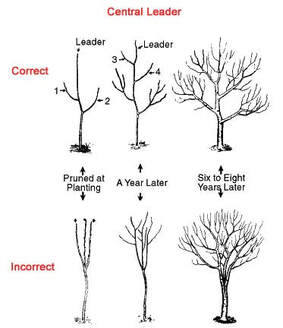There is nothing like plucking fresh apples, pears, or peaches right off the tree. There are many varieties of fruit trees to choose from, but not all are suitable for every climate or growing season. When choosing a fruit tree for your yard consider its winter hardiness, disease resistance and the ripening date of the fruit. Here, we’ll discuss planting and caring for apple trees because they are well-suited for Oklahoma’s climate. Apple trees are extremely popular to plant because of their value as nutritious snacks that are a good source of Vitamin C and fiber.
Knowing Your Hardiness Zone:
The US Department of Agriculture’s Plant Hardiness Zone Map divides the United States into zones according to the expected coldest winter temperature. Northeast Oklahoma falls within Zones 6-7 where winter temperatures are expected to get as cold as -10º F. Make sure that your chosen variety is fit for this zone to maximize fruit production.
Sunlight:
Fruit trees love sunlight, so place your tree where it can receive direct sunlight throughout the day. They need 6 to 8 hours of full sun, but avoid planting them during the heat of summer. Fruit trees should be planted in early spring, after the last frost.
Watering:
All fruit trees require well-drained soil that allows water to drain at a moderate rate without pooling and puddling. To test the drainage of your soil, dig a hole 1-foot deep by 1-foot wide. Fill the hole with water and record how long it takes for the water to completely drain. The ideal time is between 10 and 30 minutes. If you do not have well drained soil you may add amendments such as compost, peat moss, vermiculite, wood chips, or sand.
Spring in Oklahoma coincides with the rainy season, so there may not be a consistent schedule for watering. The best way to determine when trees need water is to check the soil. What you’re aiming for is moist — not soggy — soil. In the absence of rain or moisture, check the soil with a garden trowel to a depth of two inches. If the soil is dry to the touch, your tree needs water. During a summer afternoon, up to half of the water can be lost to evaporation. The best time to water is in the morning or evening, so the roots have a chance to absorb most of the water.
How often you should water will depend on the size of your tree, soil conditions, and weather conditions. Newly planted trees require much more water than established ones. Remember that clay soils can hold more water while sandy soils may need more frequent watering.
Spacing:
Most apple trees require cross-pollination. That means a single apple tree without other compatible apple trees nearby may blossom but never produce fruit. You’ll need to find a compatible variety for your apple tree that has the same bloom time. Dwarf apple trees need a spacing of 6 to 8 feet, semi-dwarf trees about 15 feet, and standard or full-sized trees about 25 feet. You’ll also need to observe your surroundings to make sure you don’t run into future problems such as overhanging electric lines, underground pipes or cables, locations too close to foundation or sidewalks.
Pruning:
The best time to prune apple trees is in late winter or early spring while the tree is still dormant before active growth begins for the season. Buds are easier to see to work around and cut wounds have a chance to dry up before insects come out in the spring. You will see less effects on winter hardiness and overall tree health. Pruning is especially effective with apple trees. See the graphic for a basic illustration on how a pruned apple tree should look over time.

Planting:
- Dig a hole about a foot wider than the diameter of the root ball and deep enough to allow the tree to be planted with the graft union, a raised lump or “bump” towards the root ball on the trunk, two to three inches above ground.
- Carefully place your fruit tree into the hole, centered on the mound, and spread its roots.
- Fill the hole with clean topsoil (with added amendments, if necessary), carefully covering the roots. Pack the soil in by gently stamping it down with your feet.
- Water the tree with two to five gallons of water, poured slowly enough so that water absorbs into the ground and doesn’t run off.
- All newly planted fruit trees benefit from being staked. This will result in a straighter tree with more growth. Staking is especially important for trees planted on a wind-blown site and for dwarf trees.
- Use mulch, herbicide or cultivation techniques to create a weed-free zone at the base of the tree that extends out to form a circle with a diameter of two to three feet. Nutrient-rich mulch doubles as an excellent fertilizer, helps soil retain moisture, and creates cooler microenvironments at the base of the plant.
Now that we have shared some helpful tips on planting apple trees, get out and plant! Remember proper planting techniques, selection of fruit trees, pruning, and watering to make the most out of your new apple tree.




